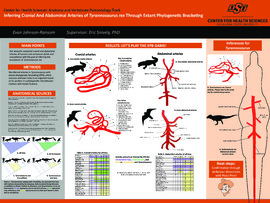| dc.contributor.author | Johnson-Ransom, Evan | |
| dc.contributor.author | Snively, Eric | |
| dc.date.accessioned | 2020-05-05T19:37:46Z | |
| dc.date.available | 2020-05-05T19:37:46Z | |
| dc.date.issued | 2020-02-28 | |
| dc.identifier | ouhd_johnsonransom_inferringcranialand_2020 | |
| dc.identifier.citation | Johnson-Ransom, E., & Snively, E. (2020, Feb. 28). Inferring cranial and abdominal arteries of Tyrannosaurus rex through extant phylogenetic bracketing. Poster presented at Research Day at Oklahoma State University Center for Health Sciences, Tulsa, OK. | |
| dc.identifier.uri | https://hdl.handle.net/11244/324213 | |
| dc.description.abstract | Synopsis: Our research compared cranial and abdominal arteries of humans and archosaurs (birds and crocodilians) with the goal of inferring the vasculature of Tyrannosaurus rex. | |
| dc.description.abstract | Background: In vertebrates, cranial arteries supply structures of the head, and branches from the abdominal aorta supply the viscera. Although human vasculature is well known, details of vasculature are unknown for most vertebrates, especially extinct ones. We investigate arteries in the extinct dinosaur Tyrannosaurus rex using its extant archosaur relatives (birds and crocodilians), with the aim of understanding how vessels contributed to this dinosaur's extreme size and functional adaptations. This study is the first to infer abdominal vasculature in an extinct organism. | |
| dc.description.abstract | Methods: We inferred arteries in Tyrannosaurus with extant phylogenetic bracketing (EPB), which assesses unknown traits in an organism based on its position in a phylogenetic tree between relatives with known features. EPB is useful for inferring traits (i.e. soft tissue) that do not fossilize well. We examined the abdominal and cranial arteries of predatory and non-predatory birds (modern dinosaurs), crocodilians (their nearest relatives), and humans through literature sources and dissections. Humans represent the distantly-related outgroup to archosaurs; arteries present in all three groups strengthens their inference for Tyrannosaurus. | |
| dc.description.abstract | Results: Abdominal Arteries: In all four vertebrates the large abdominal aorta bifurcates distally into the right and left common iliac arteries, and archosaurs possess a large caudal artery supplying the tail. The coeliac trunk from the aorta has left gastric, splenic, and common hepatic; birds lack splenic and common hepatic arteries with the gastric artery anastomosing with the coeliac trunk, whereas crocodilians have a gastric artery that branches into the gastro-hepatico-intestinal artery and pancreo-intestinal artery. These arteries supply foregut structures. Branches of the superior mesenteric artery supplies the midgut and inferior mesenteric artery the hindgut. Crocodilians only possess one mesenteric artery, which supplies the entire intestinal tract. Humans have paired middle suprarenal arteries and renal arteries. Archosaurs lack middle suprarenal arteries, but have renal arteries that supply both the adrenal glands and kidneys. All vertebrates have paired gonadal arteries. | |
| dc.description.abstract | Cranial Arteries: In all vertebrates, vertebral arteries supply the brain, and the common carotid bifurcates into external and internal carotids. The external carotid supplies structures of the neck and head external to the cranium, branching into the superior thyroid, ascending pharyngeal, lingual, facial, occipital, posterior auricular, maxillary, and superficial temporal arteries. Archosaurs' external carotid branches into temporomandibular, pterygoid, maxillomandibular, palatomaxillary, maxillary, palatine, and oromandibular arteries. The internal carotid artery supplies the brain, eyes, and forehead. In humans, the internal carotid artery branches into the anterior cerebral, middle cerebral, posterior communicating, and ophthalmic arteries, whereas archosaurs' internal carotid artery branches into the cerebral carotid, common encephalic, stapedial, temporoorbital, and caudal auricular arteries. | |
| dc.description.abstract | Inferences for Tyrannosaurus: As an archosaur, we can confidently infer that Tyrannosaurus possessed temporoorbital, rostral auricular, cerebral carotid, mandibular, palatomaxillary, oromandibular, palatine, medial nasal, common nasal, and opthalmotemporal arteries. Birds and crocodilians differ is some cephalic and abdominal arteries, and their inference in Tyrannosaurus will require a search for shared osteological correlates for these vessels. | |
| dc.format | application/pdf | |
| dc.language | en_US | |
| dc.publisher | Oklahoma State University Center for Health Services | |
| dc.rights | The author(s) retain the copyright of have the right to deposit the item giving the Oklahoma State University Library a limited, non-exclusive right to share this material in its institutional repository. Contact Digital Resources and Discovery Services at lib-dis@okstate.edu or 405-744-9161 for the permission policy on the use, reproduction or distribution of this material. | |
| dc.title | Inferring cranial and abdominal arteries of Tyrannosaurus rex through extant phylogenetic bracketing | |
| osu.filename | ouhd_johnsonransom_inferringcranialand_2020.pdf | |
| dc.type.genre | Presentation | |
| dc.type.material | Text | |
| dc.subject.keywords | tyrannosaurus | |
| dc.subject.keywords | arteries | |
| dc.subject.keywords | phylogenetics | |
| dc.subject.keywords | archosaurs | |
